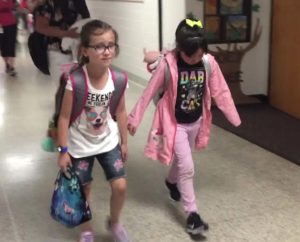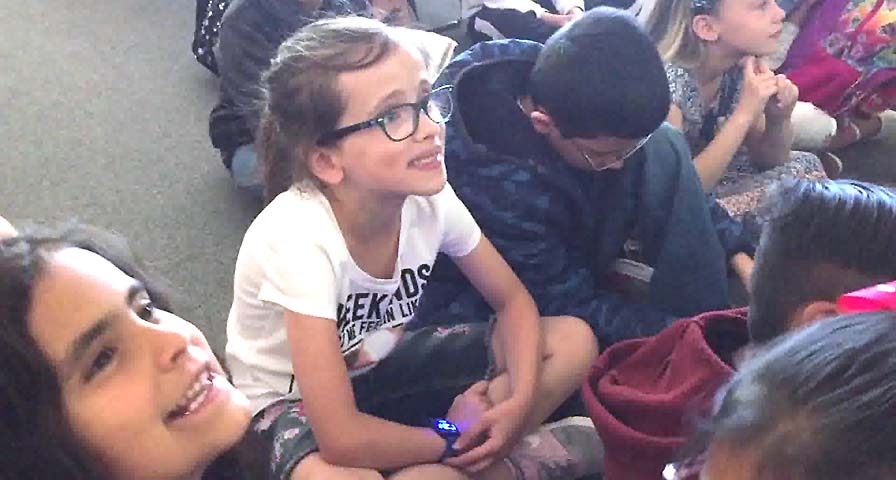All-Day Wear of IHT ZONE Education Heart Rate Monitors Helps Students Identify When to Use Self-Regulation Techniques Taught during SEL Lessons
East Elementary (Littleton, Colo.) students use IHT ZONE heart rate monitors to teach themselves how to manage the stress and anxiety they feel during the school day.
Last year, East Elementary officials implemented a program known as Operation Dragon Heart, in which select students wear IHT ZONE monitors for the entire school day.
“Our goal with Operation Dragon Heart was to address the social and emotional self-regulation needs of our students,” said Principal Kelly Card.
Teachers could see when students had trouble regulating their emotions and behaviors but needed a tool to help them identify an impending behavioral issue. Often times, Card said, incidents are indicated by an unexpected change in heart rate, so the principal, along with school counselor Kim Bailey, searched for a heart rate monitor that would provide students with real-time feedback throughout the day. That search uncovered the IHT ZONE, which displays both heart rate and color associated with the current heart rate:
- Blue indicates a low or resting heart rate;
- Yellow indicates moderate heart rate;
- Red indicates an elevated heart rate.
“We were looking for something that was going to be durable, that was going to be light, user-friendly for students, and we wanted it to look cool,” Card said. “We wanted to give a heart rate and we wanted it to light up and give them a visual representation of what was happening in the moment and that’s exactly what IHT does.”
For the initial 6-week session of Operation Dragon Heart, named after the school’s mascot, Bailey worked with different teachers to identify students who would be the first users. Some students had previously struggled with self-regulating their emotions and behaviors. Teachers recommended other students.
Using ‘In Focus’ Techniques to Self-Regulate Heart Rate
After a series of introductory meetings with students to explain the process, the heart rate monitors and recommended techniques to control emotions, students began using the ZONE monitors. They pick up – activate – the monitors at the beginning of the school day and return them at the end. Upon returning the monitors, Bailey, the classroom teachers and the students and parents receive a report detailing the student’s heart rate throughout the day.
East Elementary’s counseling staff implemented a social-emotional learning unit using the In Focus curriculum. In Focus delivers age-appropriate content that teaches students to control their impulses and emotions and enables them to calm down and, in Bailey’s words, re-regulate themselves. In January, 2020, NBC’s Today Show profiled their efforts.
“The vision is to link children with regulating their emotions, being able to physically see what’s happening in their body,” Bailey said. “Then they can associate that with the feeling and they are able to use the techniques we’re using to help calm themselves down.”
Students said they improved their ability to manage their emotions and behaviors by controlling their heart rate.
 “I was really emotional and now I’m a little bit stronger and calmer,” said second-grader Charlotte Sherwood. “I feel it’s made a big difference since I started wearing the monitor.”
“I was really emotional and now I’m a little bit stronger and calmer,” said second-grader Charlotte Sherwood. “I feel it’s made a big difference since I started wearing the monitor.”
Nichole Noonan, whose daughter took part in the program, said the combination of the technology and explanations by the counseling department helped her daughter improve her self-awareness.
“I’ve seen a difference,” Noonan said. “It’s made a difference with all of the different elements together. Using the monitors made my daughter more mindful about how she goes through the day and gave her some perspective about when she’s feeling stressed. And the staff at East is teaching strategies to help her get through those moments.”
Utilizing Heart Rate Monitors to Reinforce Social-Emotional Lessons
Card said a key to the program’s early success has been students’ ability to manage the technology. In today’s technology-driven world, she said, that’s expected.
“Our kids are tech-savvy,” she said. “They are on devices all the time and having that number to help them correlate to how they’re feeling helps give them that connection to, ‘Oh! This is what my body is doing,’ and gives them this window to what is going on inside.”
And it didn’t take long for that connection to show. After a few In Focus lessons, a student put some of the techniques into practice.
 “I was able to watch a student in week one who was having an emotional moment where he was struggling,” Card said. “He was upset about things and he was able to look at the number on his [monitor] and incorporate some of the breathing exercises we had been learning about. He sat and watched the number on his [monitor] go down and get into his normal range, which was so cool to see….especially for this particular student.”
“I was able to watch a student in week one who was having an emotional moment where he was struggling,” Card said. “He was upset about things and he was able to look at the number on his [monitor] and incorporate some of the breathing exercises we had been learning about. He sat and watched the number on his [monitor] go down and get into his normal range, which was so cool to see….especially for this particular student.”
For the 2019-20 school year, students have just completed some of the In Focus lessons and are preparing for the next session of Operation Dragon Heart. Bailey said administrators have three main focal points for this year’s sessions:
- Hold more discussion sessions with participating students. “This helps get buy-in from the students and [lets them reflect] on what they notice.”
- Improve how teachers identify students who may need to self-regulate. “We need to be better at identifying things as they are happening and to speak up when we see students who need to focus on their monitor.”
- Include more personalized information on the participating students. Bailey can individualize each monitor to each student by adding details such as height, weight and max heart rate. Adding each student’s individual max heart rate helps better define the heart rate zones and can give students and teachers an accurate idea of when fitness is improving.
Card said community feedback has been extremely positive. That support helps drive the program forward.
“Our students that are involved are so appreciative of this opportunity,” she said. “We have several parents who have really been behind spearheading this, and some of them are in the mental health field. Some of them have emailed the superintendent saying all kids need to do this, and so it’s good to hear that this is the right work we’re doing for our kids.”


